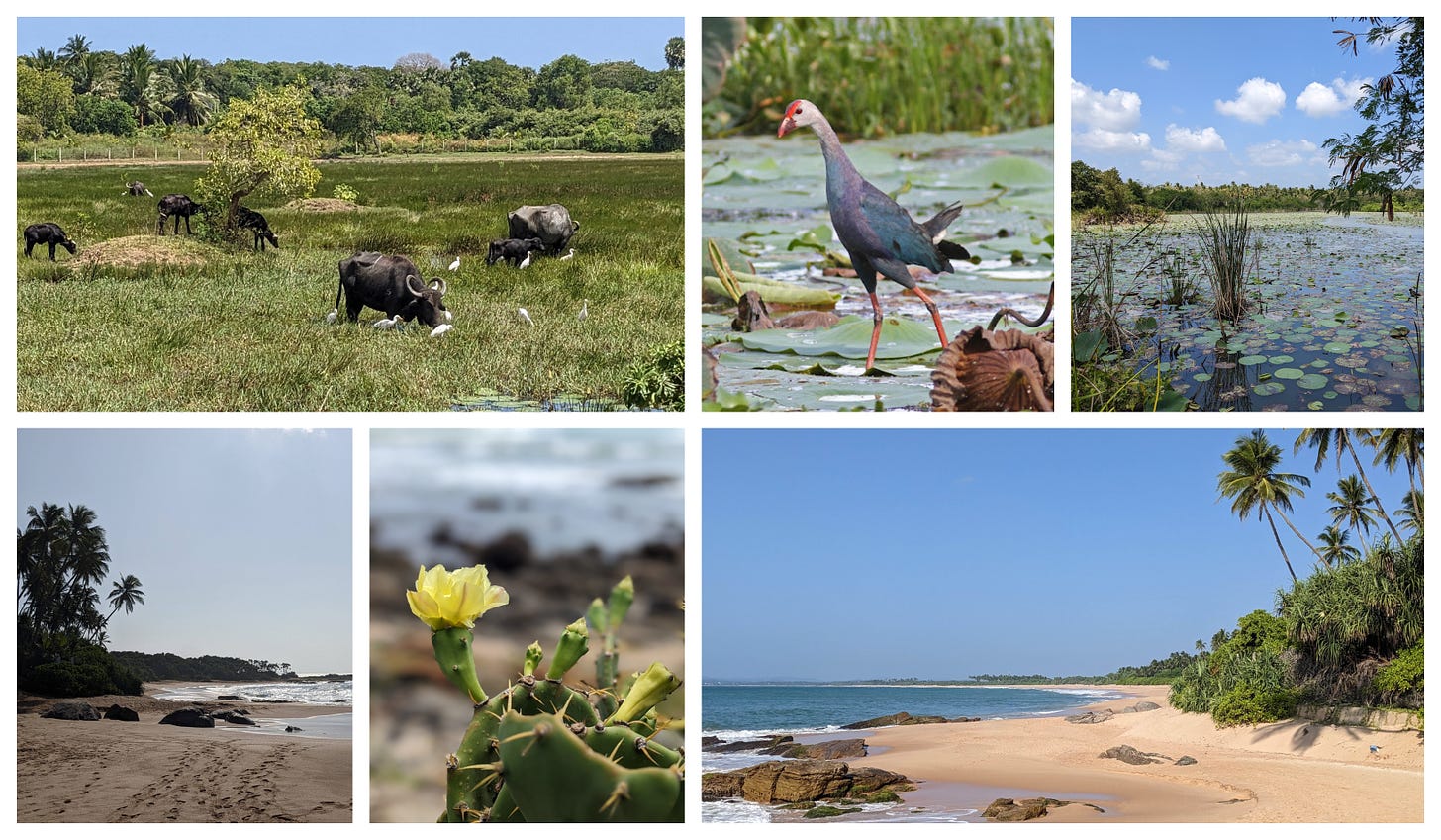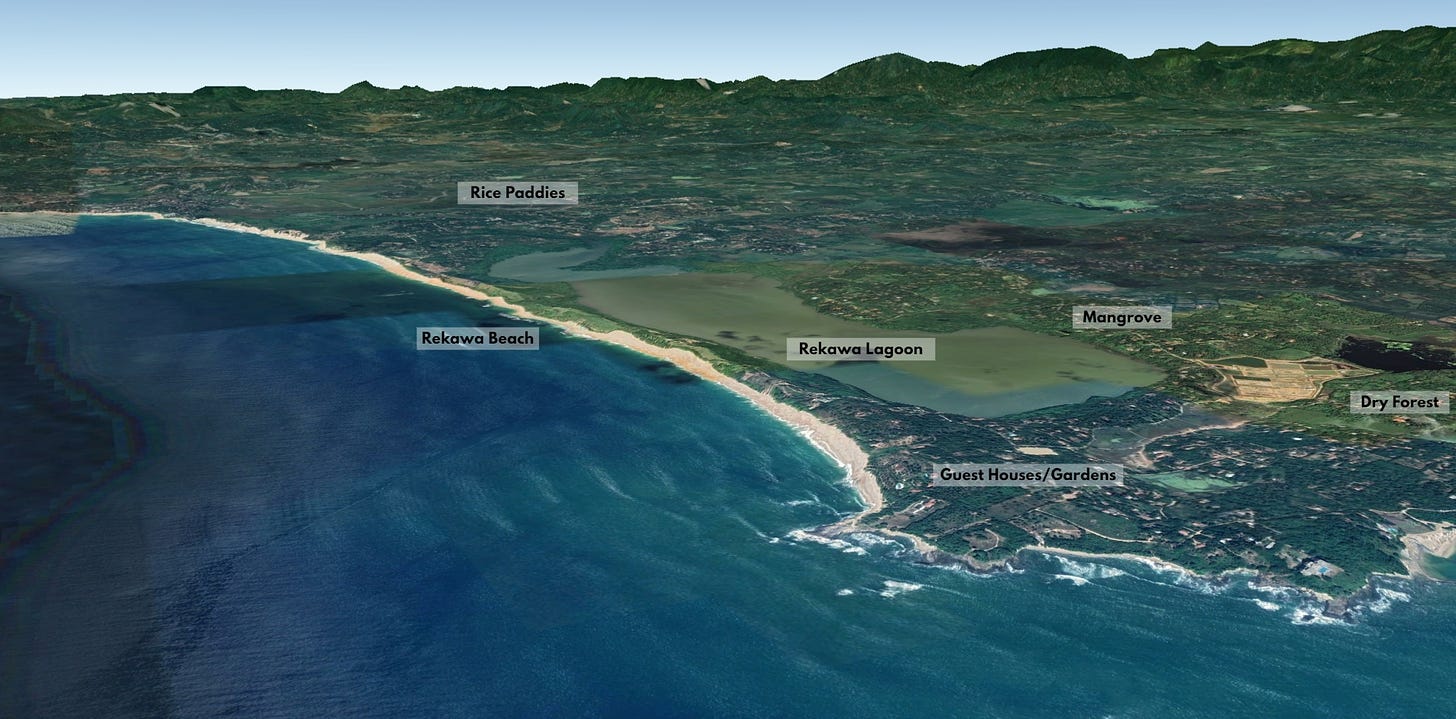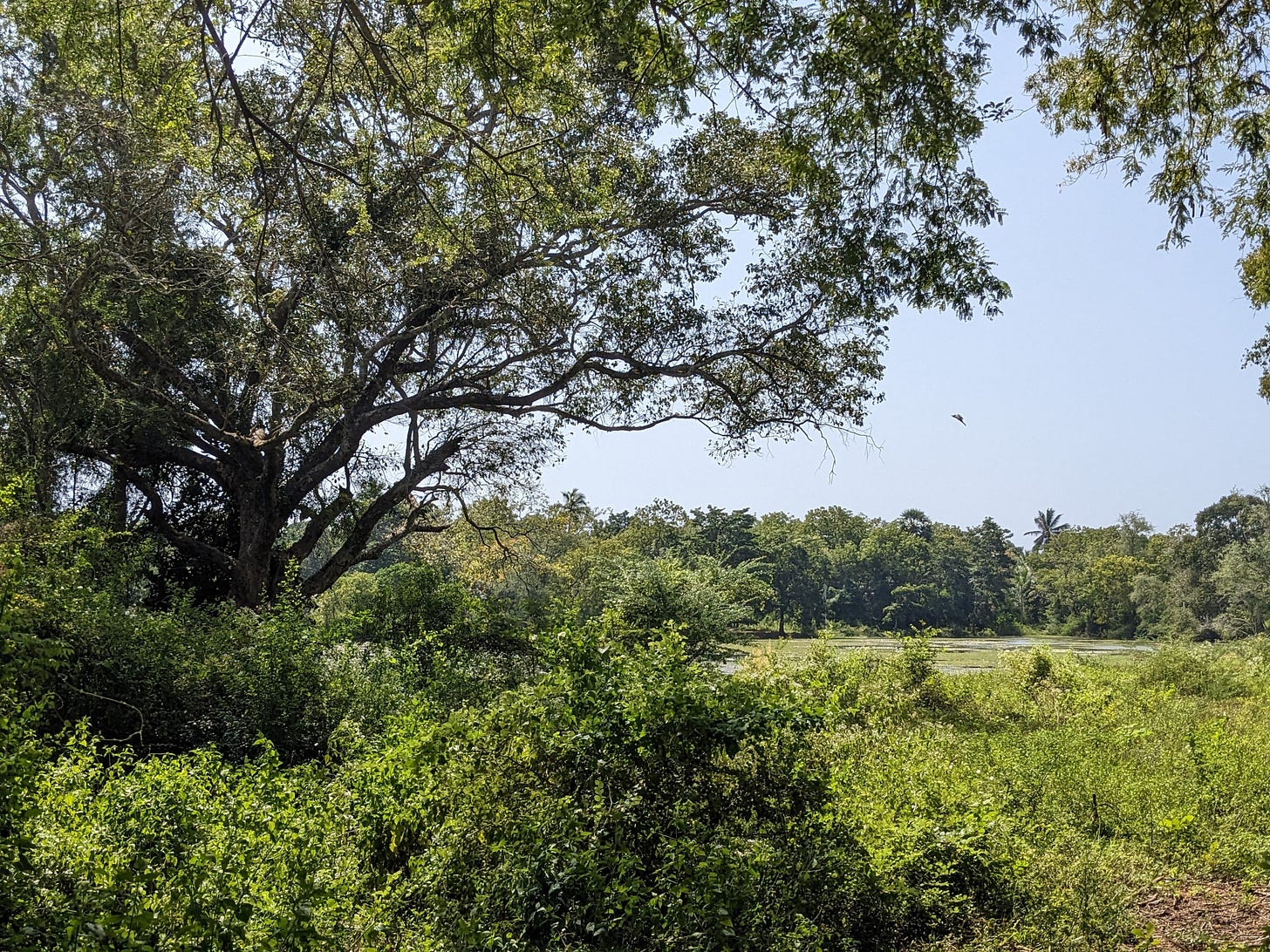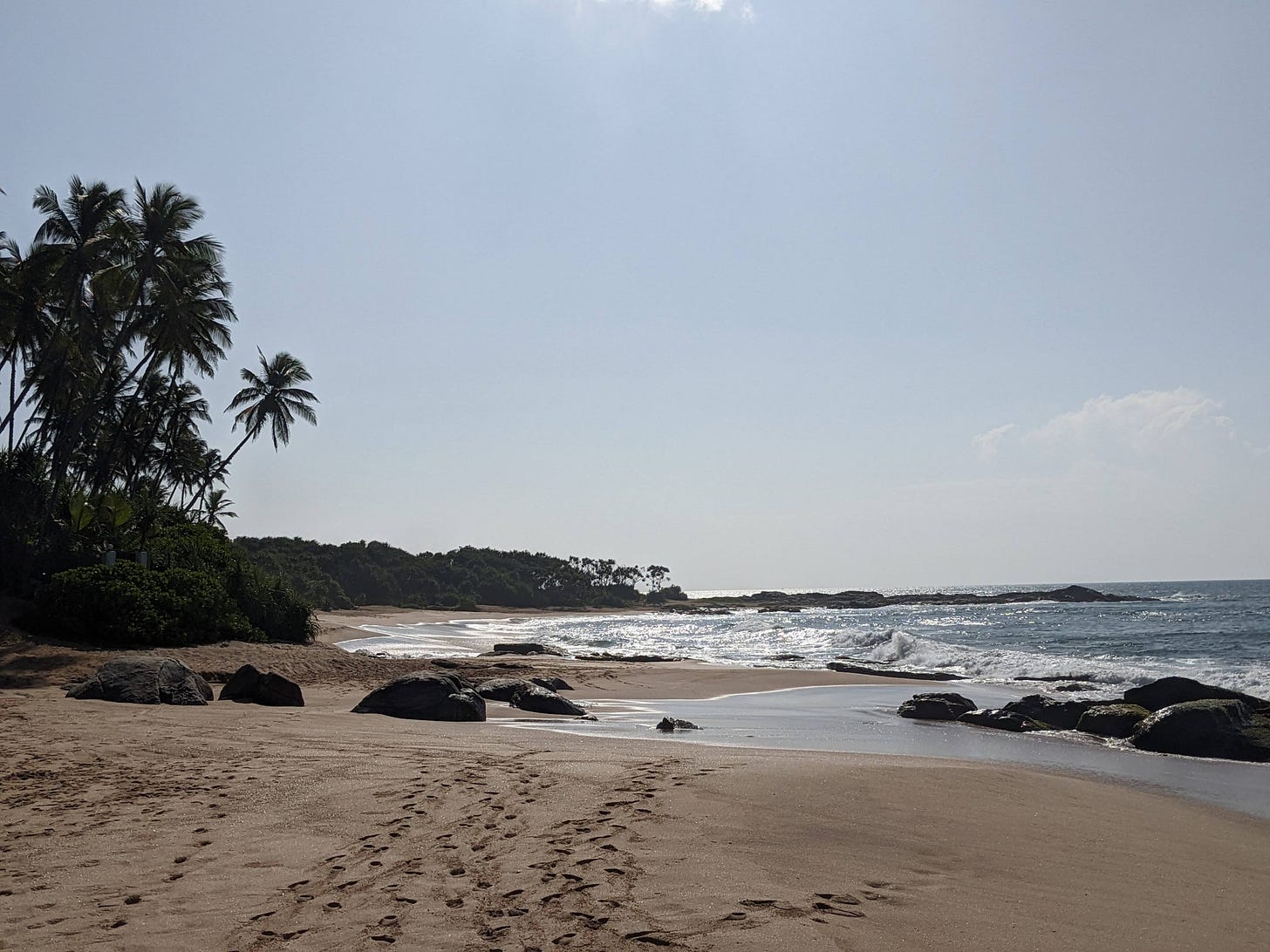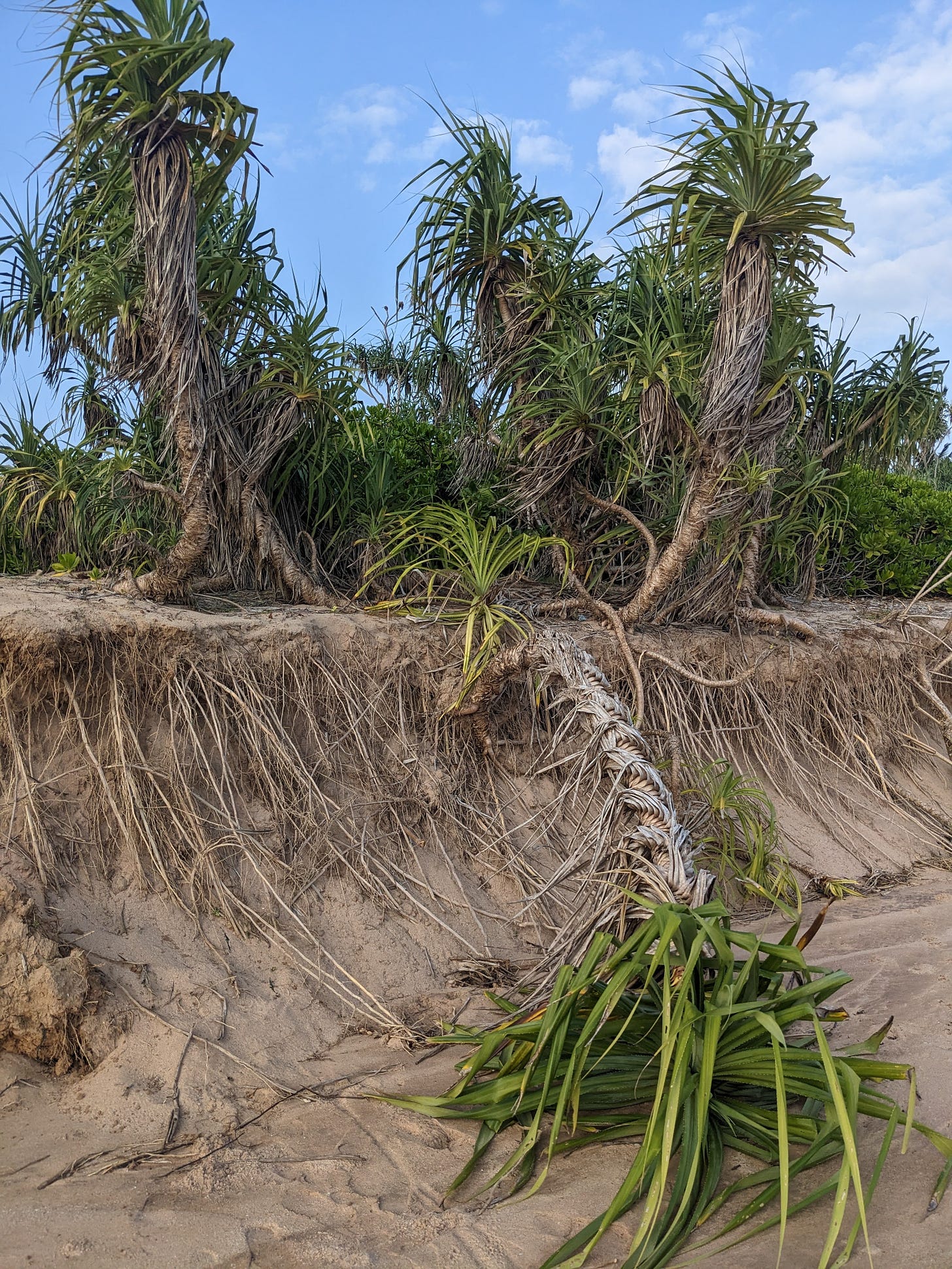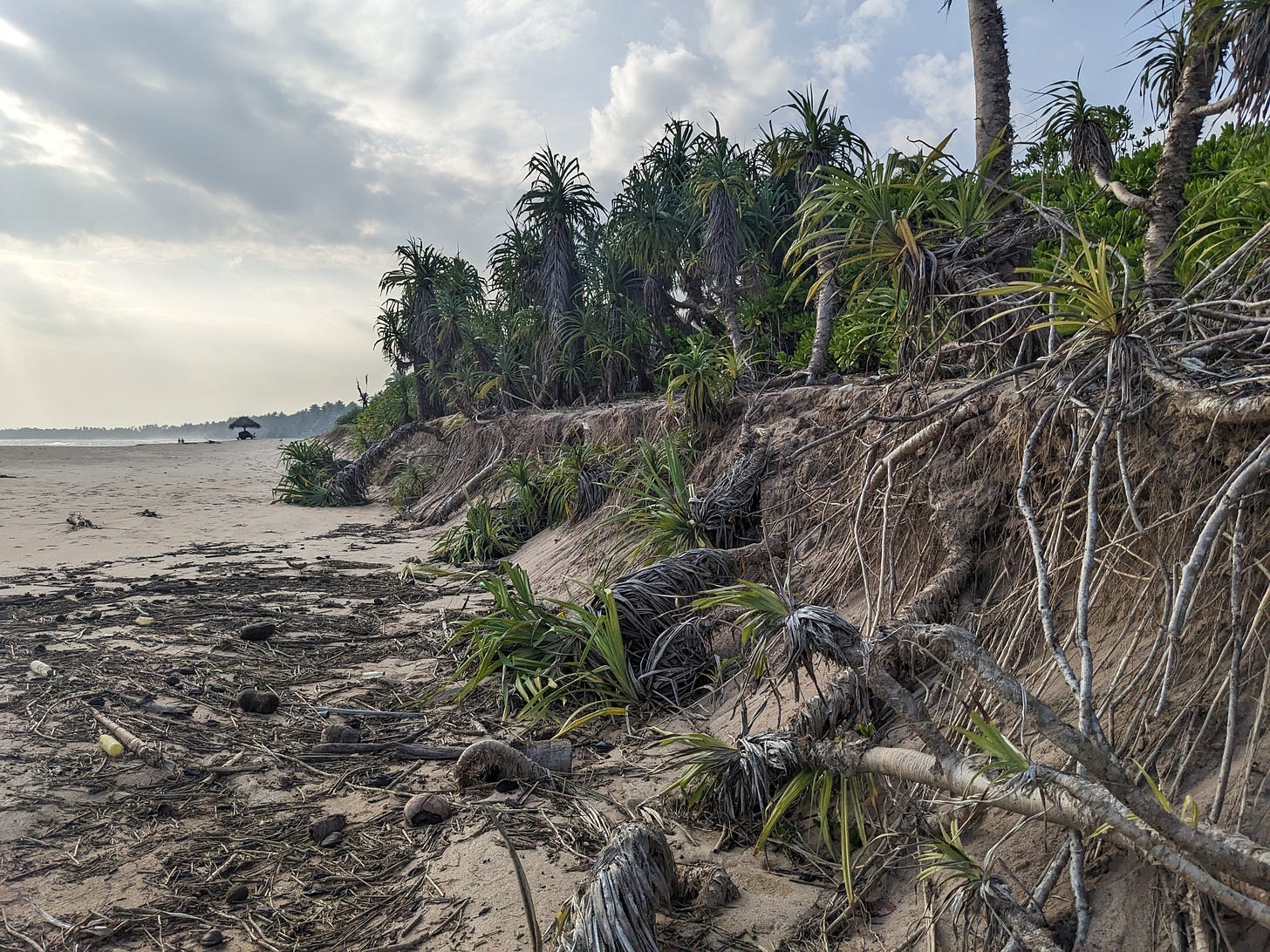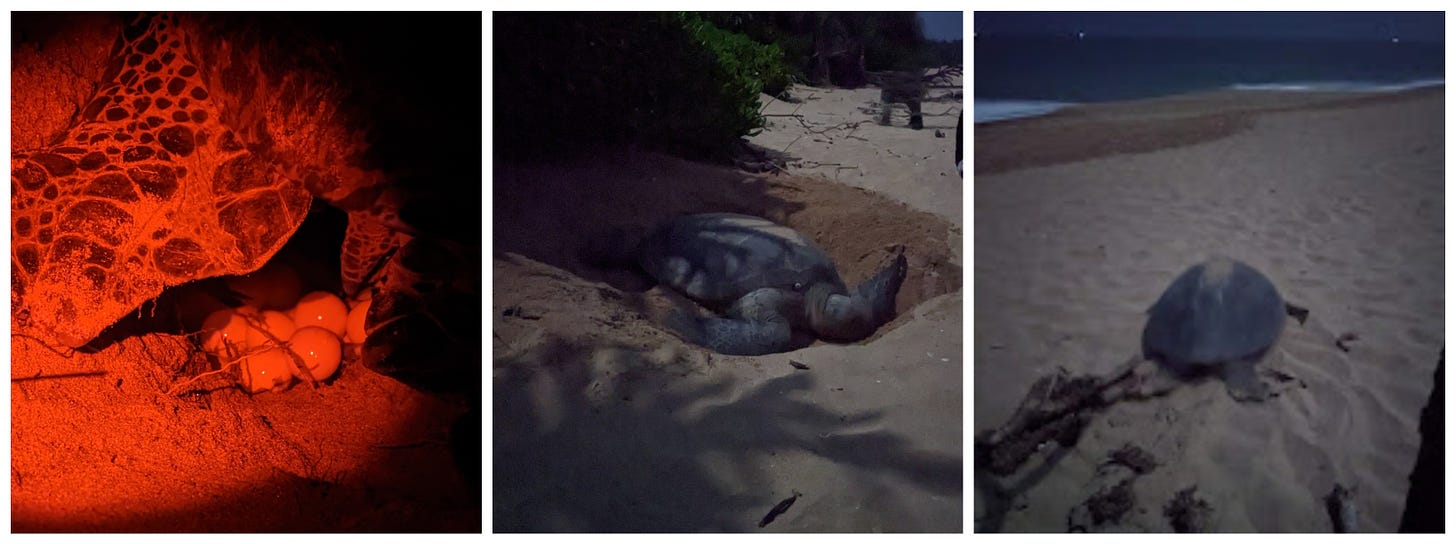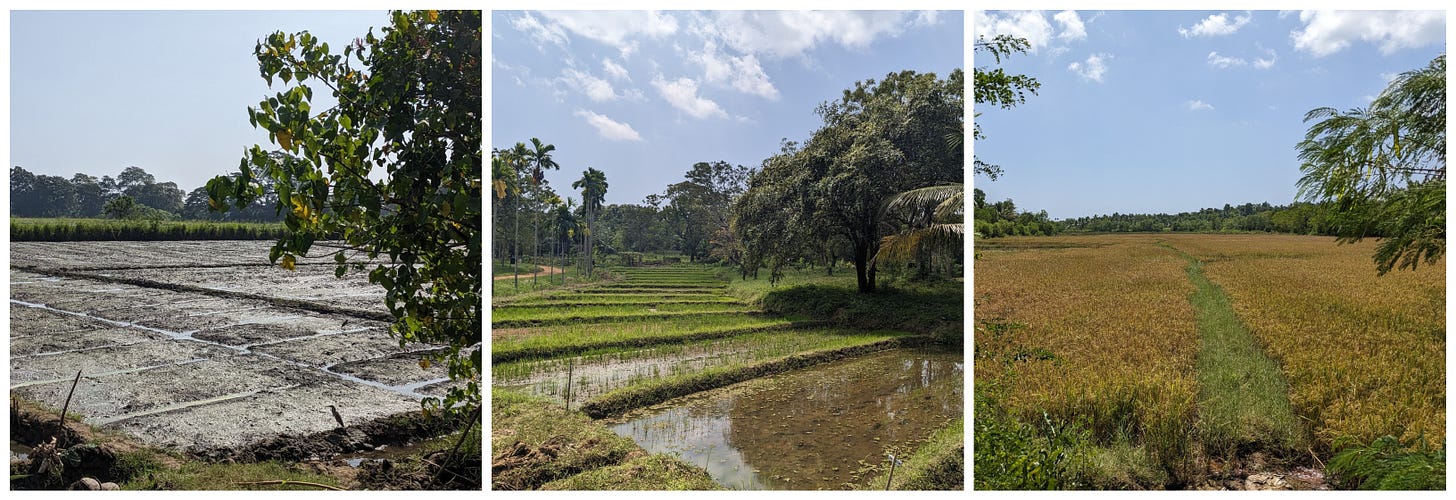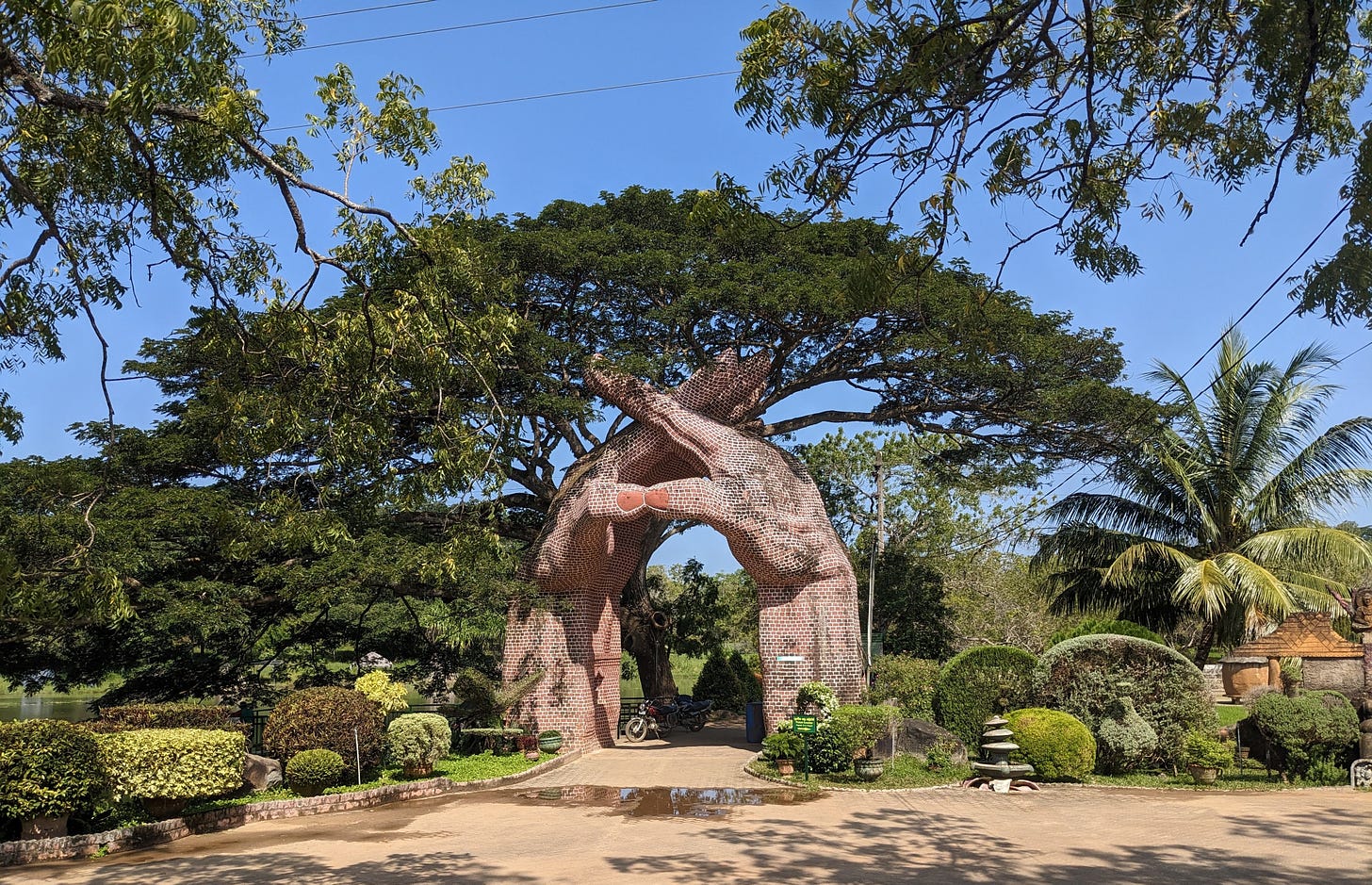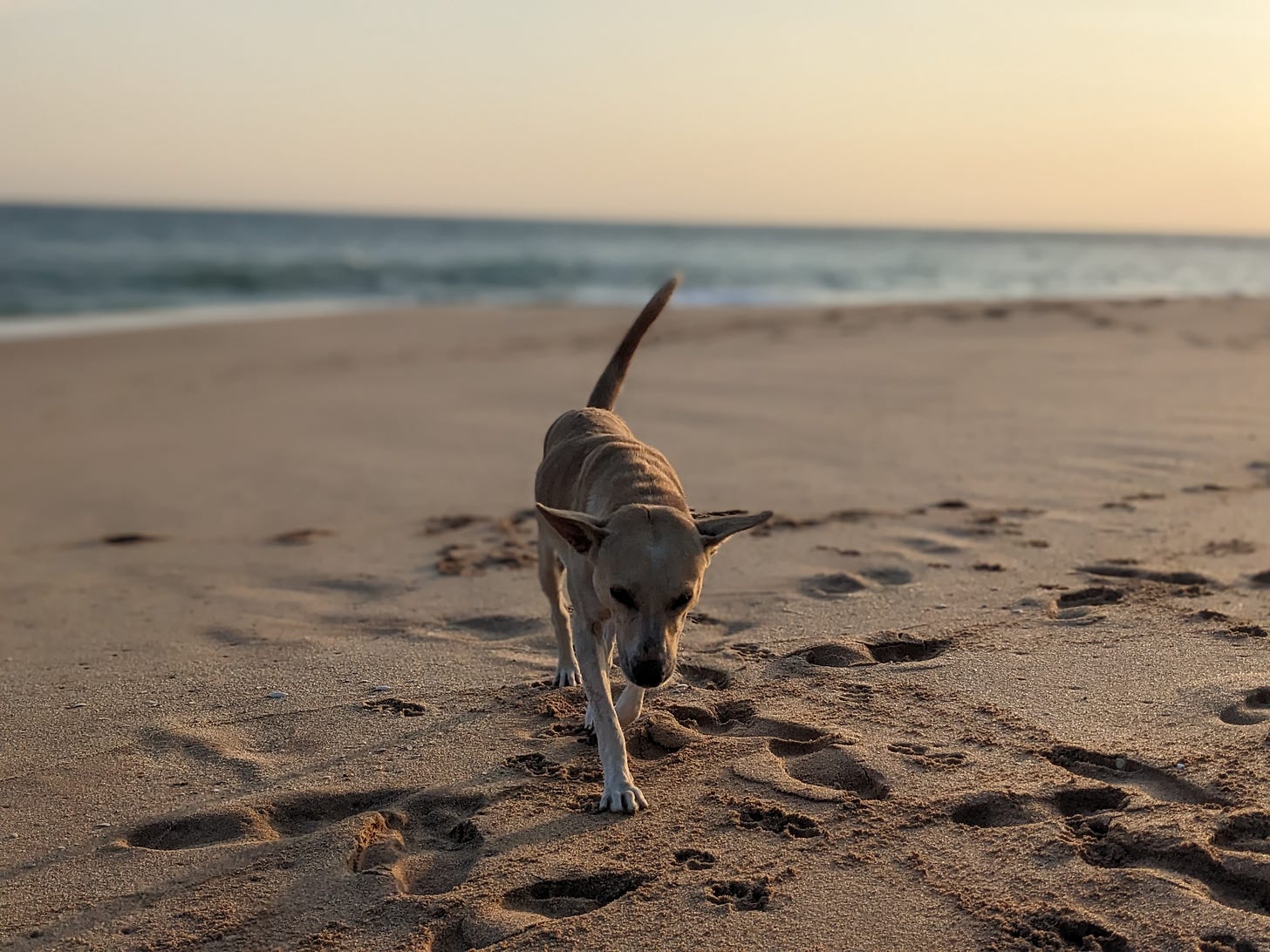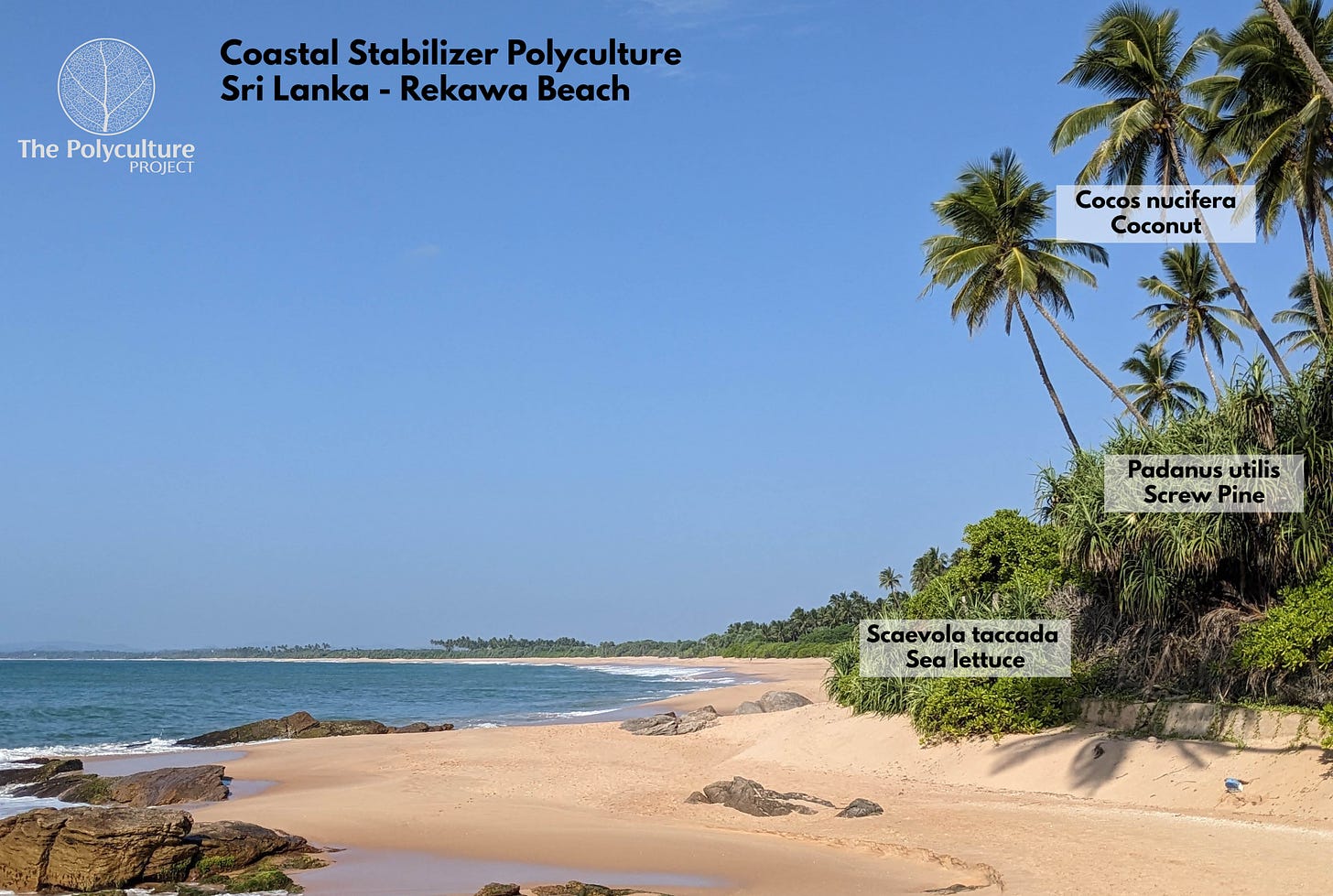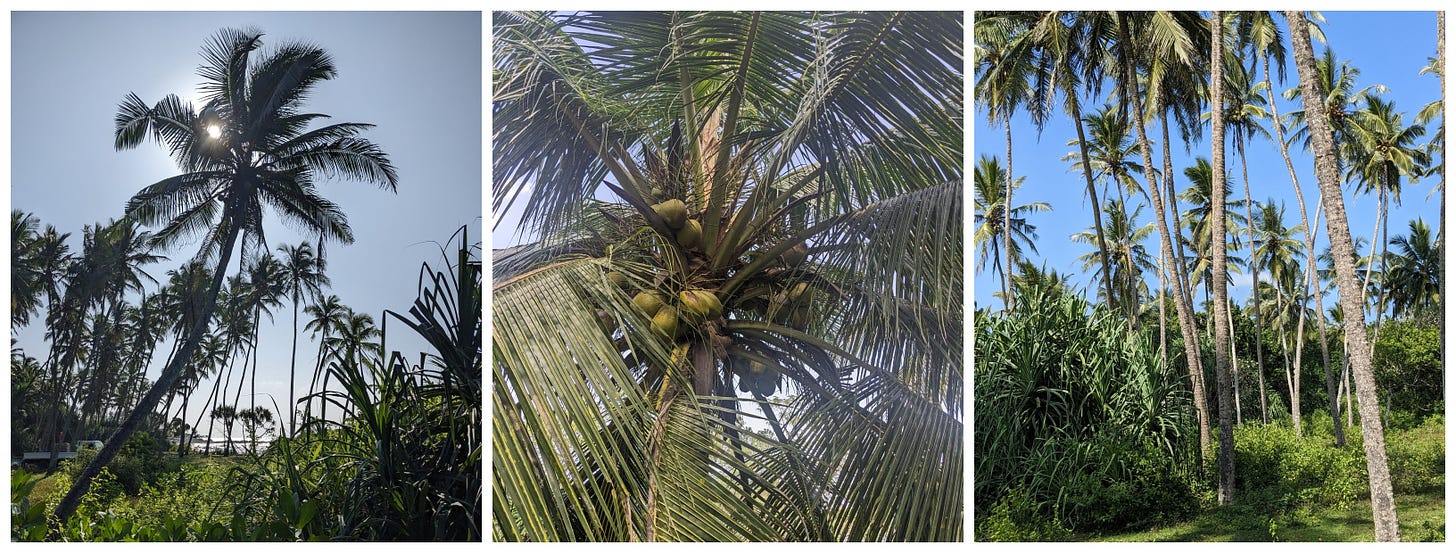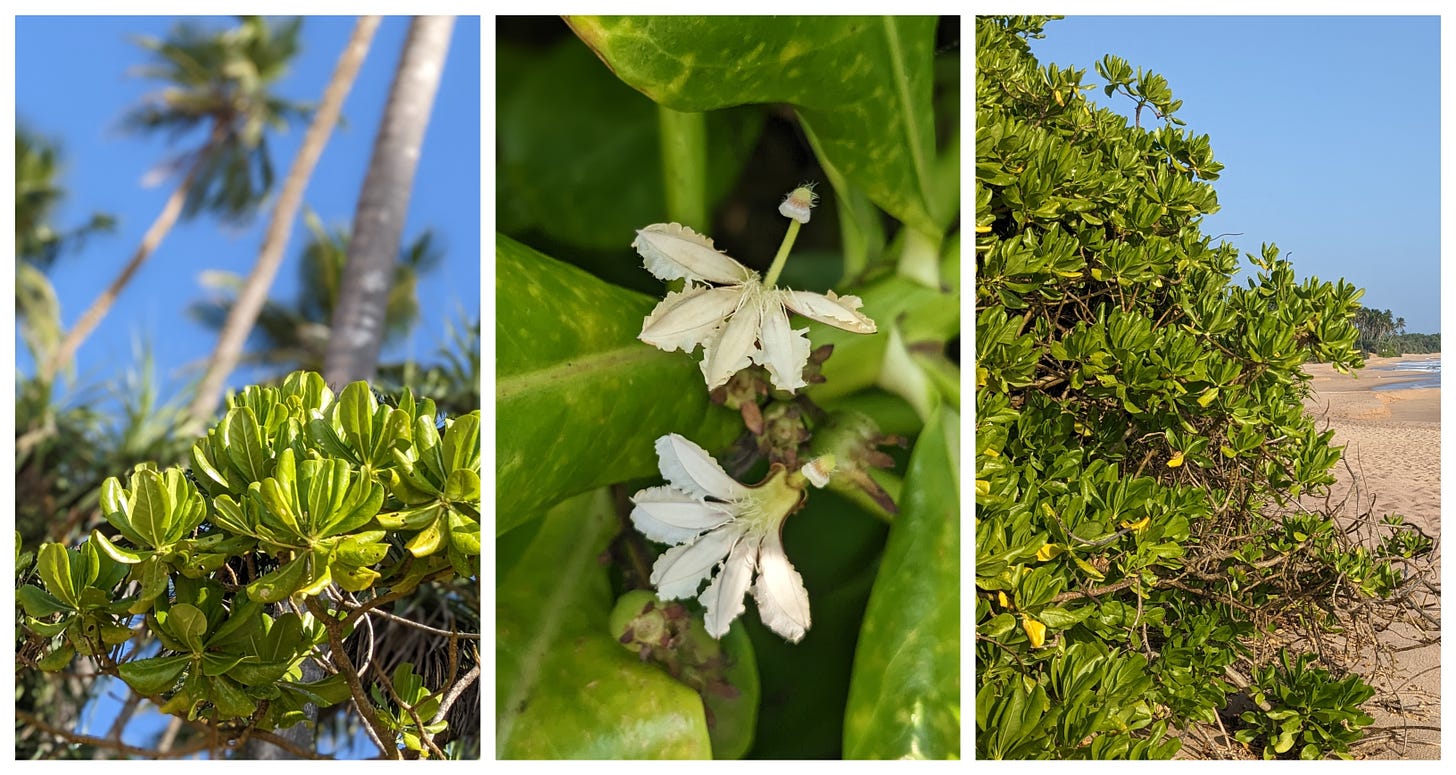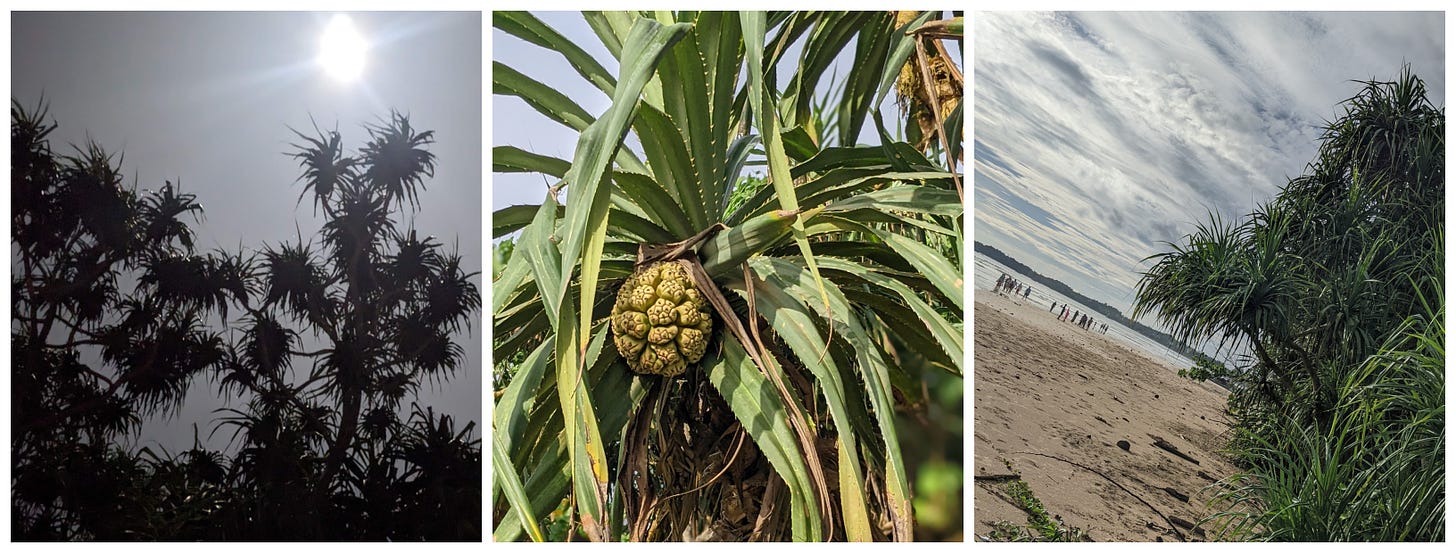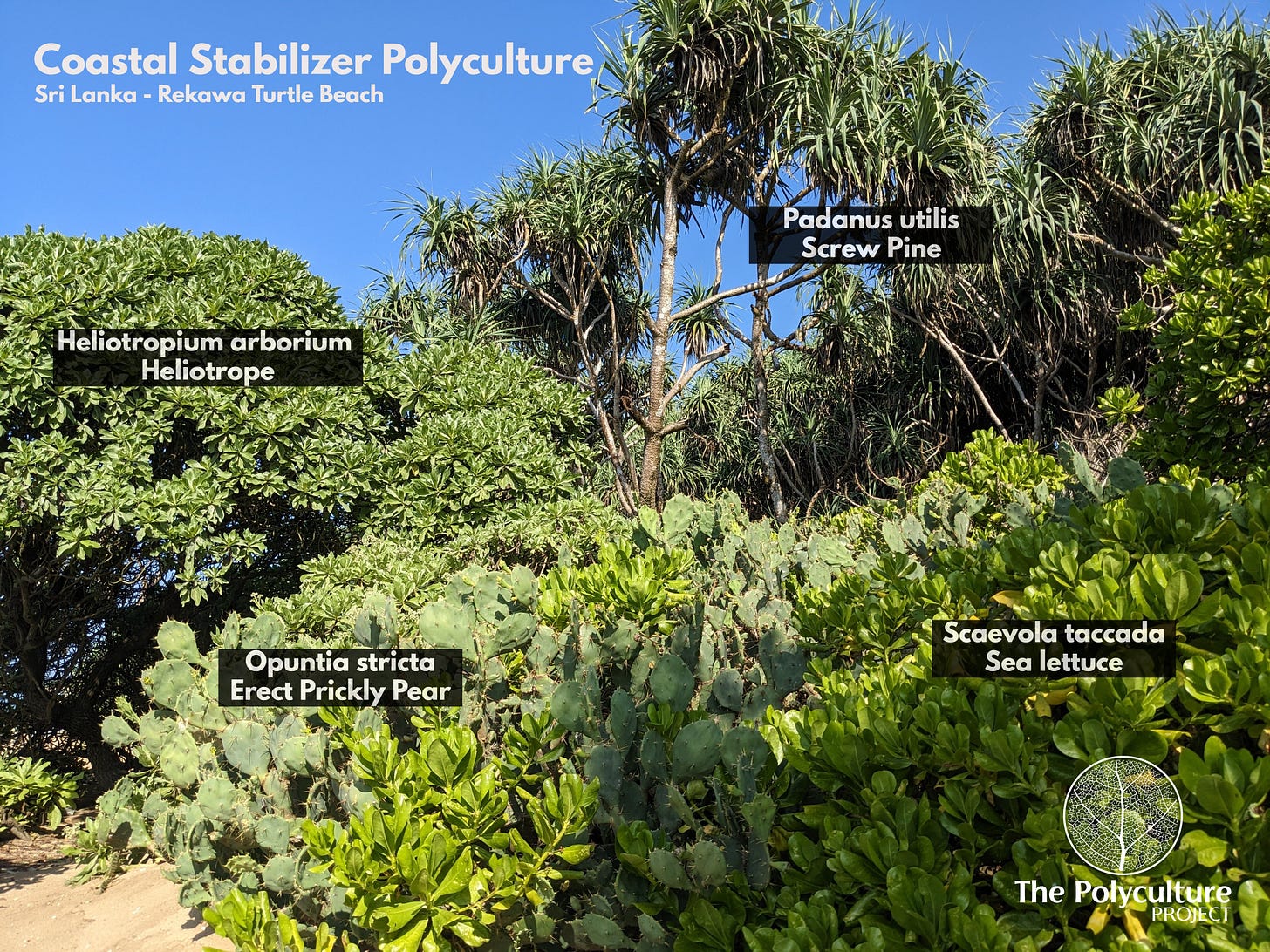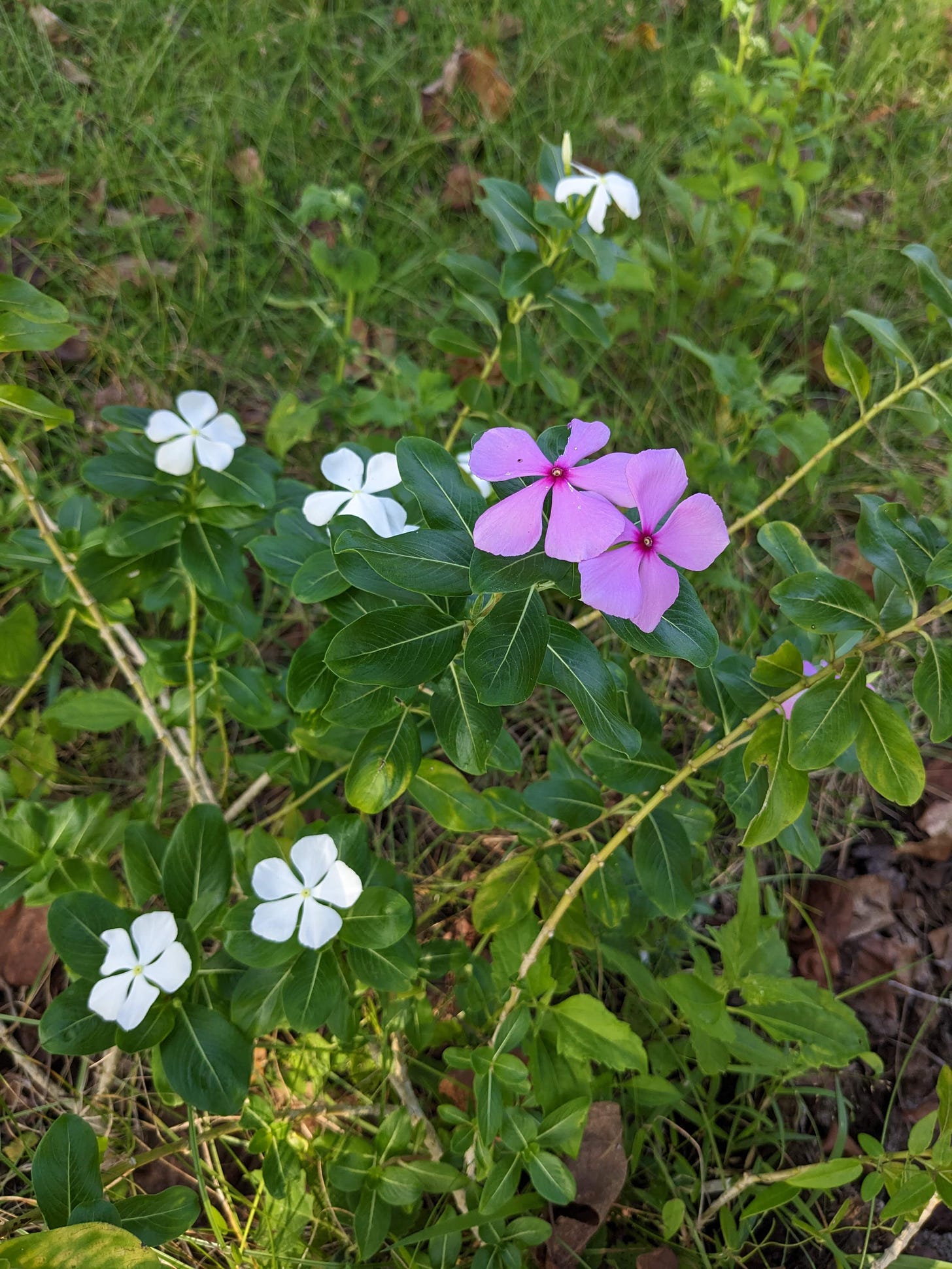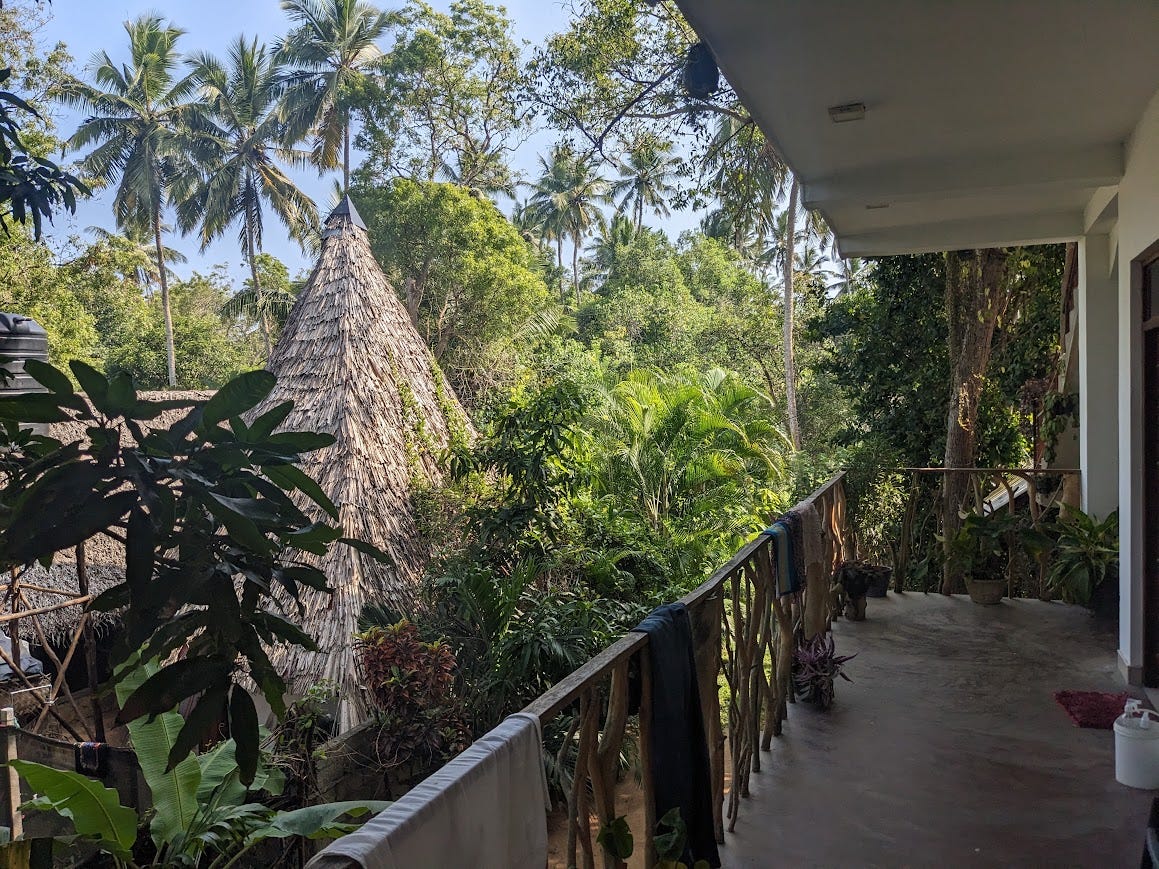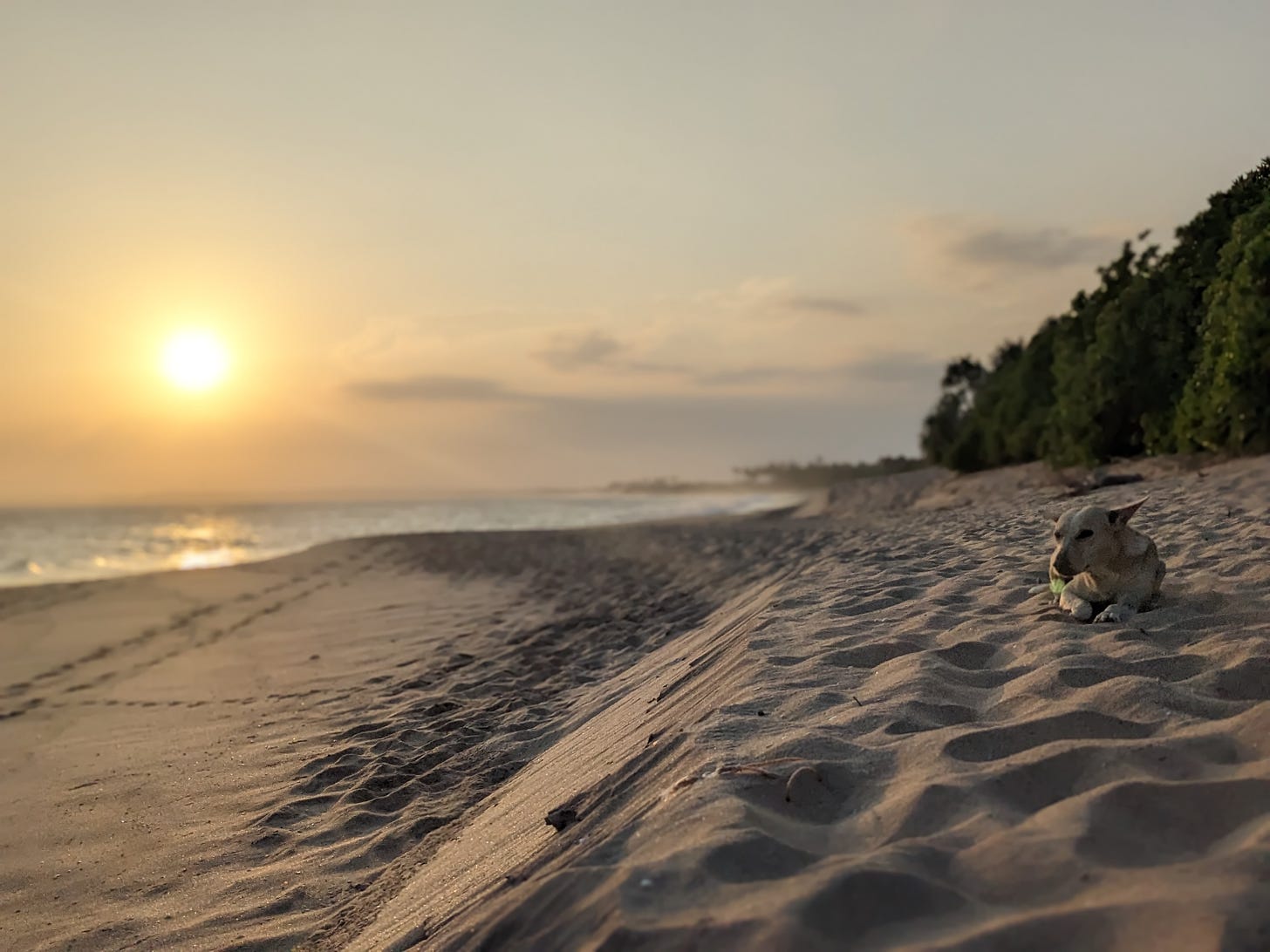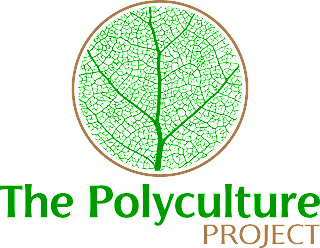Wild beaches, lagoons, forest, wetlands and lovely people, during this post we’ll take a closer look at the area, it’s climate, habitats, local cultivation practices, some of the incredible wildlife, interesting plants and a coastal stabilizer polyculture that does the job very well.
Overview of the Area
Rekawa is located, near Tangalle in Hambantota district, in Southern Province, Sri Lanka around about the 6th Parallel North looking out to the Indian Ocean
Rekawa is in the Dry Zone of Sri Lanka, a fascinating, historically significant, and ecologically unique region that makes up a large portion of the island. The dry zone generally receives less rainfall compared to the wet zone in the southwest, averaging around 1,200mm annually.
The terrain in this area is more or less flat with some mild undulation, there are many rivers, ponds , wetlands and a large lagoon with a wide diversity of flora associated with these different habitats.
There is plenty of water around and the water table is high but the intense heat makes evaporation rates very high. The terrestrial trees have much smaller leaves than in the wet zone and there is a lot more grassland. It reminds me a lot of wild areas, early summer in the Valley of the Roses where we live in Shipka, apart from the peacocks and meter long monitor lizards everywhere. The bird diversity and populations are much higher here too.
The place I was staying is particularly interesting as it includes two littoral zones one from the Ocean and the other from the Lagoon. The banks of the lagoon are vegetated with many mangrove species including Lumnitzera racemosa, Aegiceras corniculatum, Bruguiera gymnorhiza, Excoecaria agallocha, Rhizophora mcronata, Avicennia marina, and Avicennia officinalis.
The Beach
Rekawa Beach is an incredibly scenic one, with a vast expanse of yellow sand, relentlessly pounded by the waves of the Indian Ocean.
Although not a family friendly swimming beach, there are a few spots sheltered from the waves and if you are a pretty strong swimmer, know how to navigate a rip tide and don’t mind getting tossed around like a rag doll every now and than, it’s a very invigorating swim.
Bordering the beach is a band of vegetation, I believe these coastal plantings are relatively new as far as I could gather, following the Boxing Day - 2004 Tsunami that wreaked havoc on much of the coastline in this area. What I think is Pandanus kaida - False Pineapple (there are some 578 accepted species in genus) appears to be a local native and does tremendous job at preventing soil/sand erosion as you can see from the deep extensive root system in the below photo
It has the added benefit of being able to root from anywhere on the stem so when the waves push up against the sandbank during storms and topple the plants they re-root and continue to grow. Often the regrowth is buried by sand and the majority of the biomass decomposes but over time starts to build up a soil like medium making it suitable for other plants to colonize the area and further stabilize the belt.
There are various different plants growing along the coastal margin and later in this post I’ll cover a polyculture that seems to be doing a great job at stabilizing the coastal belt while also providing food other resources for humans and wildlife.
A reader of our Substack, Melissa Harvey got in touch after reading this post and shared her research undertaken in Sri Lanka in 2005 after the Tsunami. Her work looked at the resilience of homestead gardens after the disaster, and Rekawa was one of her field sites. You can find Melissa’s dissertation here.
Sea Turtles
The beach is off limits from 7.00pm - 6.00am in order to maintain privacy for the five species of sea turtles that make their way to the stretch of untouched beach to lay their eggs before heading back to the ocean. Species that frequent the beach include Leatherback Turtle (Dermochelys coriacea), Green Turtle (Chelonia mydas), Olive Ridley Turtle (Lepidochelys olivacea), Loggerhead Turtle (Caretta caretta), and Hawksbill Turtle (Eretmochelys imbricata)
There are a number of conservation projects in the area which aim at protecting the nesting sites and it’s possible to arrange a turtle watching excursion in the evenings, between 8:30 pm and 11:30 pm, to catch a glimpse of turtles laying their eggs.
I went to Turtle Watch Rekawa. The local guides spot the turtles and lead the spectators to the location where you wait around until the turtle has settled in the nest and is starting to lay. Using red lights to not disturb the mother, it’s possible to catch a glimpse of the laying and if you wait around for a few hours you can sit nearby and watch the mother cover the eggs and dig her way out of the nest and finally return to the Ocean. A small contribution of 1500 LKR (around $5) per person keeps the project going and the beach protected.
Local Cultivation
Home Gardens - Pretty much all of the local gardens have a diversity of fruit and nut trees as well as root crops, herbs as well as ornamental plants. Sri Lankans love their gardens and evidentially spend a lot of care and attention on them. The majority of gardens will have Coconut, Banana, Jackfruit, Mango, Papaya and sometime Star Fruit.
Curcuma longa - Turmeric is commonly grown and probably has been for over 6,000 years. A member of the ginger family Zingiberaceae this perennial, rhizomatous, herbaceous plant is native to the Indian subcontinent and Southeast Asia.
A staple in Sri Lankan cuisine, Turmeric’s earthy, slightly peppery flavor adds depth to curries soups, stews, smoothies, and even baked goods but it’s uses extend beyond the curry pot. A thick decoction of the rhizome makes a good antiseptic and is used to wash eczema before applying medicine. It’s also applied externally on bruises, sprains and wounds and taken internally to relieve colds in the head and catarrh.
Domestic Water Buffalo - Bubalus bubalis - Herds of Water Buffalo are moved around the village throughout the day, grazing marsh lands, grass lands the mangrove edges and wallowing in the ponds. Their milk is a staple food in many parts of Sri Lanka. It is richer in fat and protein than cow's milk, and it has a slightly sweet taste. Villagers use water buffalo milk to make a variety of dairy products, including yogurt, butter, and cheese. The Water Buffalo yoghurt with wild honey is delicious.
Rice cultivation is a vital part of the agricultural landscape in Sri Lanka's Hambantota district. Lush paddy fields blanket vast swathes of the region, their emerald hues contrasting beautifully with the golden sands of nearby beaches.
Traditionally, rice farming in Hambantota relied on the seasonal monsoon rain. However, recent years have seen an increasing shift towards irrigation systems, enabling farmers to cultivate rice all year around and you can see various cultivation stages in the area. Despite these advancements, challenges remain. Saline water intrusion due to rising sea levels poses a significant threat to rice cultivation in coastal areas. The Hambantota district is particularly vulnerable to this issue, as seawater can infiltrate irrigation systems and contaminate freshwater sources.
A great place to learn more about horticultural and agricultural practices of the region is the Bataatha Agro Technology and Tourism Park. There are some excellent demo rural and urban gardens, a collection of root crops, a garden displaying lesser cultivated fruit and nuts that have potential in Sri Lanka and lots more.
I’ve not seen a garden such as this before. It’s a hybrid between a botanic garden, a research garden, an ethnographic museum and a park and it has been designed and created really well being easy to navigate with all of the exhibitions clearly labeled in Sinhala and English with a digestible amount of information



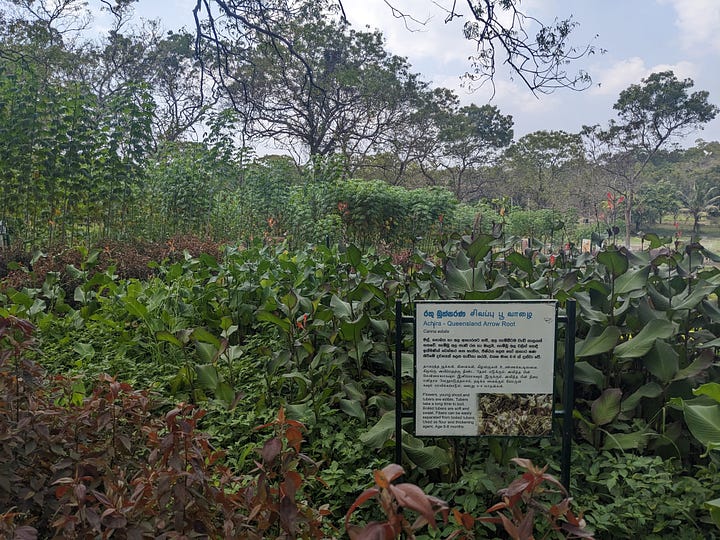
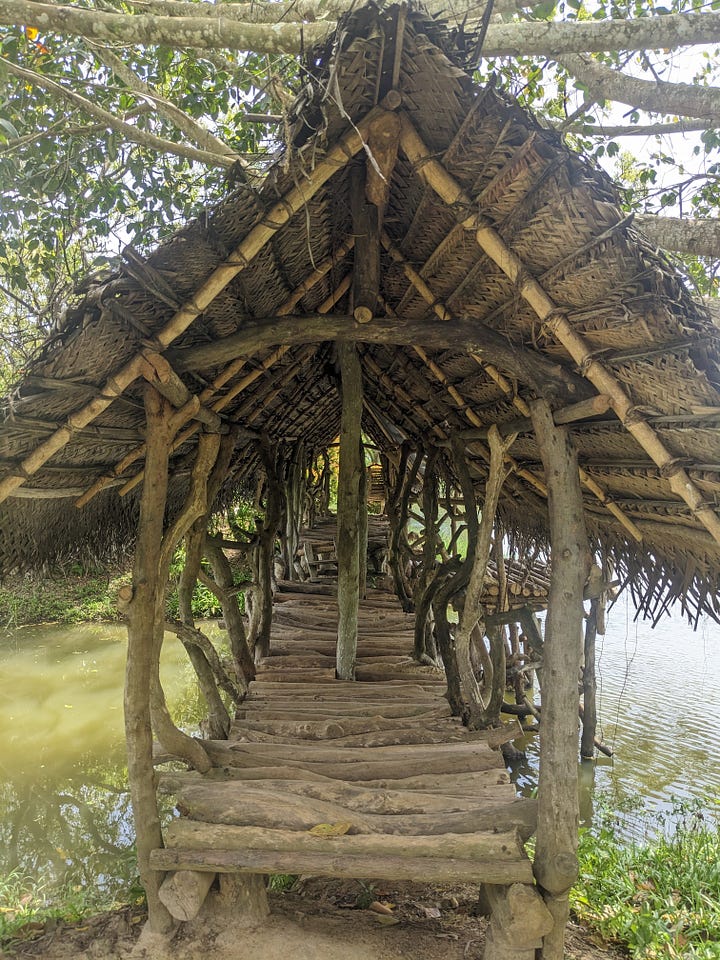
There is plenty of wildlife in the garden including mongoose, water monitors, squirrels and peacocks to name a few I saw during my walk around. The restaurant outside the park is a great place to try local homemade snacks too.
Wetland
A significant area of the land is wild wetland varying between brackish and freshwater. One of the few plants I recognized in the area was Typha angustifolia - Narrowleaf cattail dominating parts of the lowland. It was fascinating to watch the Baya Weaver - Ploceus philippinus building their nests within the reeds
Wildlife
There is an incredible array of wildlife in the area constantly on display including Tufted Langur - Peacocks, Palm Squirrels and many birds that you will mostly likely see from whichever guest house you may be staying in.
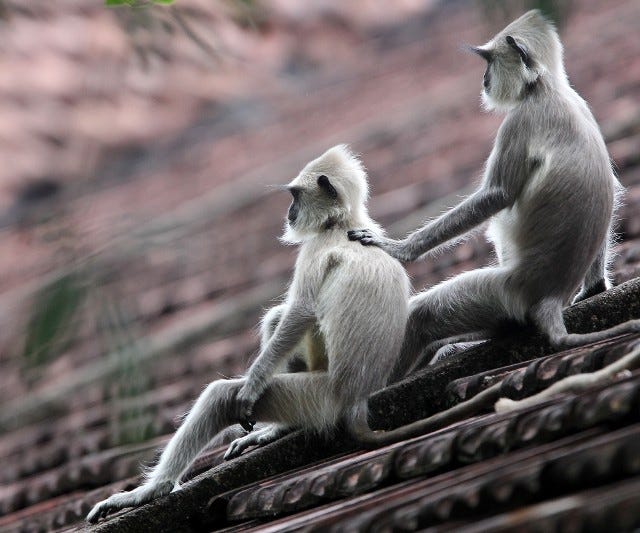
A few others that caught my attention
Weaver ants - Oecophylla sp.
Nature's miniature architects, construct intricate homes by weaving living leaves together. Their remarkable feat begins with meticulous site selection, choosing sturdy branches adorned with fresh, close-knit leaves. Then, a dance of cooperation commences. Worker ants, like synchronized threads in a loom, grasp the leaf edges and draw them closer. Meanwhile, larvae, cradled in the mouths of their kin, spin a silky thread from their glands, acting as nature's glue to bind the leaves into a secure chamber. This process, fueled by teamwork and relentless dedication, transforms single leaves into sprawling multi-chambered fortresses, some spanning several meters. But their artistry doesn't stop there. Twigs, debris, and even fallen comrades are incorporated, strengthening the structure and deterring unwelcome visitors. The result? A vibrant, living nest, shaded by the canopy, ventilated by rustling leaves, and protected by silken armor.
Oecophylla ants are opportunistic and adaptable. They can and will utilize various trees and shrubs as long as they offer the necessary support and leaf arrangement for their remarkable living nests. I think the plant in the video is Acacia auriculiformis - Ear Leaf Acacia
Birds
If you look closely around the ponds you can find Purple Swamp Hem - Porphyrio poliocephalus walking over floating vegetation or stalking through the reed beds. Their range stretches from the Middle East to Southeast Asia, with populations thriving in diverse wetlands from India to China.

Beach Dogs
Dogs probably outnumber humans on the beach and are friendly to the humans but have their territory marked out and will sometimes scrap amongst themselves.
You’ll find these type of dogs all over Sri Lanka often in small packs roaming free. They are relatively small dogs and are thought to have originated from a breed used for hunting as far back as the 5th Century. They are obviously well-suited to the climate and very intelligent having adapted to survive over the years.
Regenerative Landscape Design - Online Interactive Course
Want to learn how to design, build and manage regenerative landscapes? Join us on our Regenerative Landscape Design - Online Interactive Course. We look forward to providing you with the confidence, inspiration, and opportunity to design, build and manage regenerative landscapes, gardens, and farms that produce food and other resources for humans while enhancing biodiversity.
You can find the course details here and at the moment we have a $350 ( 20%) discount for full enrollment to the course. Just use RLD2024 in the promo code section of the registration form to receive your discount.
Coastal Stabilizer Polyculture
Whenever I'm at a new beach overlooking a horizon I've never seen before I make a point of locating the nearest land mass directly ahead and vow to visit that place. Here on the south coast of Sri Lanka that place is Antarctica.
An almost unfathomable vastness of Ocean continuously pounding against the shore takes it toil on the land and all along the beaches you will find plants trying to hold their ground.
One particular stretch of the coast , west from Rekawa Turtle Watch station the planting combination was doing the job very well and including edible plants with some good wildlife habitat integrated. It seems that all of these plants grow well in the coastal tropics around world.
The polyculture consists of three main species Scaevola taccada - Sea lettuce as a shrub layer Pandanus spp. - Screw pine in the lower canopy and Cocos nucifera - Coconut in the upper canopy.
Cocos nucifera - Coconut. The region's sandy soils, warm temperatures, and abundant rainfall provide ideal conditions for coconut cultivation and the plants are planted along the coastal belt between the beach and the lagoon with the majority under grass grazed by the local water buffalo and goats. However the palms extend to the edge of the coastal belt and serve as an upper canopy to the shrubs and lower canopy as you can see in the photo above.
Coconut palms take about 4-5 years to mature and start producing nuts, and can continue to bear fruit for up to 80 years. The Hambantota District is known for its high-quality coconuts, which are used for a variety of purposes. The nuts are eaten fresh, dried, or used to make coconut oil, milk, and cream. The leaves are used for roofing, thatching, and making baskets. The trunks are used for building materials and furniture.
Scaevola taccada - Sea lettuce dominate the shrub layer of the coastal planting. The shrub thrives in harsh coastal environments, tolerating high winds, salt spray, and sunbaked sand. The plant has occasionally be used for food, the white fruit and the young leaves cooked but mainly as emergency food. There are many medicinal uses for the plant in it’s native range of East Africa.
Its branches can sprout roots wherever they touch the ground, anchoring the plant and preventing soil erosion. This makes it a crucial player in stabilizing coastlines and protecting beaches from storms. Large branches can be used as cuttings to create a very fast forming hedge.
Pandanus spp. as mentioned above are remarkable plants very common around the coastal belt throughout Sri Lanka and play a prominent role of stabilizing the coastal belt.
Although not used as food in Sri Lanka, Pandanus leaves are edible and the fleshy pulp of the fruit is cooked and enjoyed for its starchy, pleasant flavor in some countries in Africa.
Other areas of the belt there is more plant diversity and noticeably more invertebrate activity. Heliotropium arborium - Velvet leaf soldier bush, one of the few shrubs in flower within the coastal planting belt along this beach was packed with pollinators including, butterflies, dragon/damsel flies, beetles and small Diptera
Heliotropium arborium has a wide range of uses, especially in the Pacific Islands where it used as a food, has several valuable medicinal uses and provides a range of materials. An excellent species for providing shelter and protection in exposed, coastal areas. Birds relish the ripe berries, while some cultures consume the young leaves (though caution is advised due to potential toxicity). The leaves and branches are also used for weaving mats, fences, and traditional crafts. In some regions Scaevola has been used for treating skin conditions, wounds, and even internal parasites. More studies are needed to validate these claims and understand the plant's full medicinal potential.
Other Remarkable Plants from Around the Area
Catharanthus roseus - Madagascar Periwinkle
Sharing the same flower as Vinca and from the same family Apocynaceae, I came across this plant used as a ground cover on the sandy soils around various hotels. Interestingly beneath its delicate beauty lies a fascinating secret: it's a powerful life-saver
The plant produces over 70 alkaloids, some of which have become crucial weapons in the fight against cancer. Vincristine and vinblastine, extracted from the plant, are used in chemotherapy to treat various cancers, including leukemia, Hodgkin's lymphoma, and certain types of lung cancer. These alkaloids disrupt cell division in cancer cells, effectively stopping their growth and spread.
Opuntia erecta - Erect Prickly Pear can be invasive in Sri Lanka where it has overgrown a 30 kilometer long coastal area between Hambantota and Yala. But it seems to be behaving well on Rekawa beach , probably due to an already well established coastal belt. The seeds are spread by macaque monkeys, that eat the large fruits. The fruits of all Opuntia are edible and the Cladophylls of 'most' Opuntia are edible including this species.
Here is a short video of the vegetation on costal littoral zone where the river meets the Indian Ocean.
A Few Travel Tips
Best time to visit is during the dry season from Dec - March as the south-western monsoon brings rain to this region between May and September.
A good way to get around if you want to explore the surrounding area is on Scooter which costs around $6 or $7 per day to hire. Most of the guest houses and restaurants will have a few Scooters for hire and if you are in a group of three a Tuk-Tuk works pretty well.
Mosquitoes can be annoying in the evening. You’ll find 100% natural ayurvedic mosquito repellent, in most pharmacies, that uses pure plant essences of Citronella and Lemongrass that works well.
I can recommend Turtle Paradise Hotel, a family run guest house with delicious home cooked food by Ayesha, and wonderful wildlife around the gardens.
I’ll leave it here with a photo of the sunsetting on Rekawa Beach along with my favorite beach dog, Tikstar, on account of the number of ticks I removed from him.
Support Our Project
If you appreciate the work we are doing you can show your support in several ways.
Become a member of the Bloom Room. A $70 annual subscription to our Substack provides you with access to live sessions, design tutorials, a members forum and more, see details here.
Make a purchase of plants or seeds from our Nursery or Online Store
Joining us for one of our Practical Courses or Online Courses
Comment, like, and share our content on social media.
We offer a diversity of plants and seeds for permaculture, forest gardens, and regenerative landscapes including a range of fruit and nut cultivars. We Deliver all over Europe from Nov - March. - Give a happy plant a happy home :)
Welcome to our Online Store where you can find Forest Garden/ Permaculture plants, seeds, bulbs, and Polyculture multi-packs along with digital goods and services such as Online Courses, Webinars and eBooks. We hope you enjoy the store and find something you like. It's your purchases that keep our Project going.
You can also find our full list of trees. shrubs and herbs for forest gardens on our nursery website.

